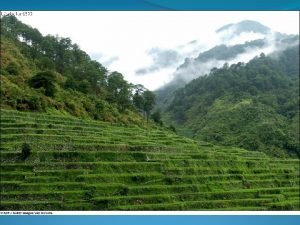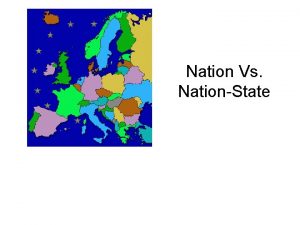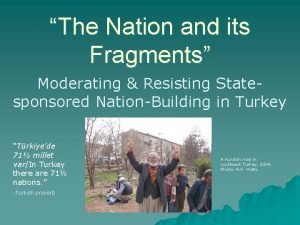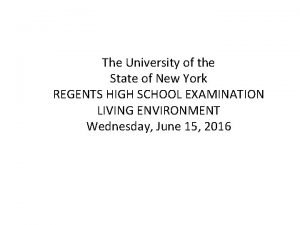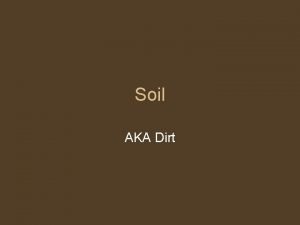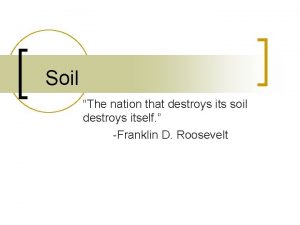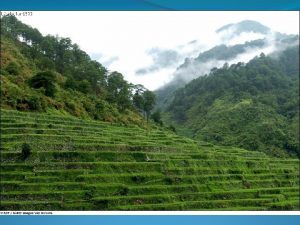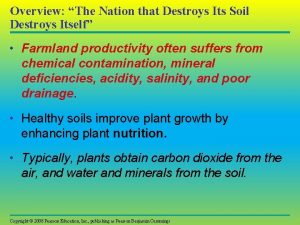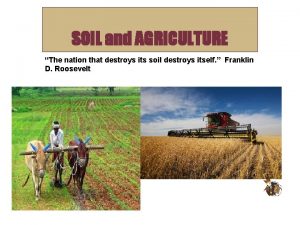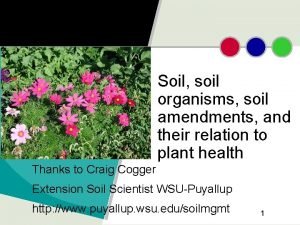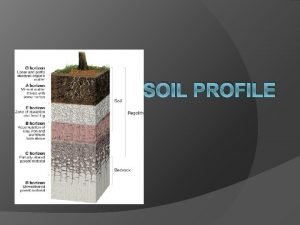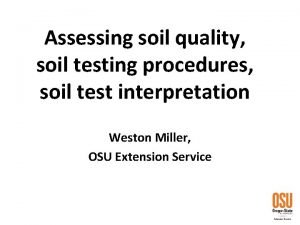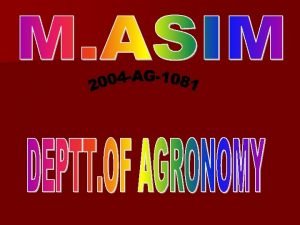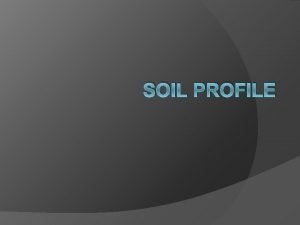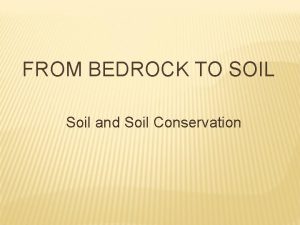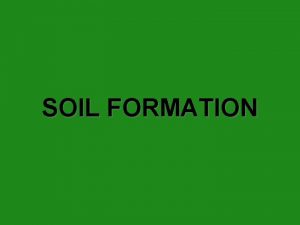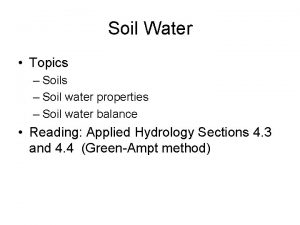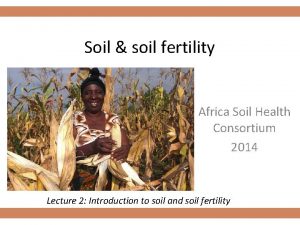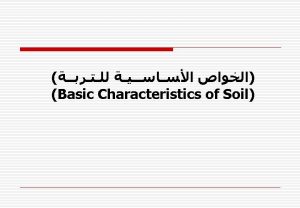Soil The nation that destroys its soil destroys








































- Slides: 40

Soil “The nation that destroys its soil destroys itself. ” -Franklin D. Roosevelt

State Soil- Orovada soils are extensive in northern Nevada, where they have an extent of more than 360, 000 acres. They are common soils on semiarid rangeland with sagebrush-grass plant communities. Orovada soils are arable when irrigated and are considered prime farmland. Alfalfa for hay and seed, winter wheat and barley, and grass for hay and pasture are the principal crops grown on these soils. Orovada soils are well drained and formed in alluvium derived from mixed rock sources and in loess and volcanic ash. These soils typically occur in the Great Basin section of the Basin and Range physiographic province. The mean annual precipitation is about 8 inches, and the mean annual temperature is about 47 degrees F.

Why study soil? n n Soil stores & purifies water Waste products & chemical pesticides are destroyed by soil microorganisms (Percolation) Sediment in water and dust in air contributes to pollution of our environment Production of our food depends on it

Formation of Soil n 1. Living matter ¡ n 2. Climate ¡ n n Based on temperature & precipitation 3. Parent materials 4. Relief ¡ n Animals, plants, microorganisms Slope and landform 5. Time

It takes 1 year to make 1 mm of topsoil

Processes most responsible for soil formation n Weathering ¡ ¡ n Erosion ¡ ¡ n n Breaking down of rock Physical, Chemical & Biological n **Know examples (Ch 9 textbook) Movement of rock/dirt Wind or water Deposition Decomposition (adds nutrients)

Layers of soil= HORIZONS n Soil profile Mineral horizon Heavily leached area Zone of illuviation for leached material from A & E horizons. Rich in clay, Al or Fe

Acronym for Soil Layers n O(organic material)- Only A(top soil)- Americans E(zone of leaching)- Eat B(Subsoil) - Bacon C(Regolith)- Covered R(Bedrock)- Raisins

*Not to be confused w/hummus Humus n n Dark-colored organic material that remains after decomposition of leaf litter, drippings, & plant/animal remains Plant roots & decomposers are found in O & A horizons ¡ n O= leaf litter; A= nutrients Benefits: ¡ ¡ ¡ Nutrient benefits Water holding capacity Aeration capacity Promoting root growth Increasing porosity of soil

Leaching n Leaching: When minerals or ions dissolved in water percolate downward, making them unavailable for plant use ¡ The degree of weathering & amount of organic matter decreases as we go down the soil profile

Soils have a limited nutrient reservoir & must be replenished periodically

WHICH BIOMES ARE USUALLY CONVERTED INTO ARABLE LAND?

Grasslands & Forests Rich in Organic Matter

Tropical Rainforest Soil: Nutrient rich?

CHEMICAL PROPERTIES OF SOIL

What plants need… Macronutrients Micronutrients N n P* n. K n n Ca, Mg, S C, H, O ¡ *frequently limiting factor n n n Fe Mn B Cu Zn Cl Molybdenum

How can nutrients be added to soil? ¡ ¡ Crop rotation (legumes→ provide ammonia naturally) Organic fertilizers: manure, bone meal, crop residue, compost Inorganic fertilizers: store bought bags Sewage sludge

EUTROPHICATION n n Run-off from fertilizers or animal waste… Excess N & P can lead to EUTROPHICATION ¡ causes algal bloom → blocks sunlight for other producers algae die decomposer (bacteria) population increases→ decreases oxygen in water→ larger organisms like fish die

p. H (<7=acidic >7=alkaline) n Ideal p. H: 6 -7 ¡ n Too acidic? ¡ n Fe, B, & Mn less available To make soil more acidic… ¡ n Aluminum (Al) toxic Too basic? ¡ n Why? Nutrients more soluble Add powdered Sulfur or Aluminum sulfate To make soil more basic (alkaline)… ¡ Add lime

p. H Neutral & Alkaline soils are common Acidic soils are common

Cation exchange & p. H Soil particles that are negatively charged hold cations (like Ca+2, Mg+2, K+) HOW IT WORKS: In cation exchange, plant roots donate H+ to the soil in exchange for these nutrients, which the soil particles then replenish by exchange with soil water. Cation exchange capacity expresses a soil’s ability to hold cations (preventing the soil from leaching & thus making them available to plants) & is a useful measure of soil fertility As soil p. H becomes lower, cation exchange capacity diminishes, nutrients leach away & soil instead may supply plants w/harmful Al ions.

PHYSICAL PROPERTIES OF SOIL

SOIL IS THE #1 WATER POLLUTANT Blocks out light, reducing photosynthesis this reduces oxygen levels

PHYSICAL PROPERTIES OF SOIL COLOR POROSITY & PERMEABILITY Color can be indicative Porosity: Amount of space between of soil’s nutrients particles Dark brown/black: lots of humus (organic matter) White/light gray: leaching or low organic matter Red: lots of iron Permeability: Rate at which water & air move through rock/sediment More porous → More permeable if pore spaces are connected


Soil Texture Sand 0. 05 -2 mm Silt 0. 00020. 05 mm <0. 0002 mm Clay Loam High permeability because of high porosity Low permeability Equal Ideal soil for portions of all agriculture three texture types

n Size of soil particles determines movement of groundwater

n Clay percentages are read from left to right across the triangle n Silt is read from the upper right to lower left n Sand from lower right towards the upper left portion of the triangle n The intersection of the three sizes on the triangle gives the texture class. n For instance, if you have a soil with 20% clay, 60% silt, and 20% sand it falls in the "silt loam" class.

Soil Structure A measure of the “clumpiness” of soil If soil is too compacted (large clumps) plant roots have a hard time getting air and water Farmers can create this if they till the land too often Also caused by grazing livestock

IRRIGATION= WATER USED FOR AGRICULTURE

Effects of Excessive Irrigation

WATERLOGGING n When soil is saturated with water ¡ Occurs when water accumulates underground & gradually raises the water table, due to farmers applying large amounts of irrigation water n n Plant roots die due to lack of oxygen required for cellular respiration Decomposing organisms in soil also die due to lack of oxygen.

SALINIZATION n Salinization ¡ Repeated applications of irrigation water in dry climates leads to the gradual accumulation of salts in upper soil layers n ¡ n n Stunts plant growth, reduces crop yields & can eventually kill plants & ruin land Decreasing salinization 1. Use mechanism that does not allow much evaporation ¡ n Salt collects in topsoil when water evaporates Drip irrigation or underground pipes 2. Plant salt resistant crops, like Barley

Salinization n Most severe salinization: ¡ China, India, Egypt, Pakistan, Mexico, Australia, & Iraq ¡ In the U. S. ¼ of our cropland is affected by salinization, especially in the western states

BIGGEST PROBLEM RELATED TO OVER IRRIGATING… Depletion of groundwater and surface water


Desertification n Loss of more than 10% productivity due to. . . ¡ ¡ ¡ ¡ n Erosion Soil compaction Forest removal Overgrazing Drought Salinization Climate change Expanding deserts & creating new deserts from once-fertile land

Overgrazing n n If grazing animals move from region to region without lingering in any one place too long, the vegetation can usually regenerate Overgrazing causes: ¡ ¡ ¡ Soil erosion (no vegetation to hold soil in place) Invasive species to invade Compacts soil, making it harder for water to infiltrate (plant roots are affected)

Forestry n When a tree/vegetation is removed, erosion by wind or water increases because the roots not are there to secure the soil ¡ ¡ Clear cutting can lead to severe erosion, particularly on steep slopes Alternative programs that remove fewer trees over longer periods of time can minimize erosion

Chemical Contamination Salinization Desertification
 Porosity of soil
Porosity of soil A nation that destroys its soil destroys itself
A nation that destroys its soil destroys itself State vs nation
State vs nation Nation vs state
Nation vs state Theories of origin of state
Theories of origin of state Walmart thất bại ở nhật
Walmart thất bại ở nhật Gây tê cơ vuông thắt lưng
Gây tê cơ vuông thắt lưng Block av độ 1
Block av độ 1 Tìm vết của mặt phẳng
Tìm vết của mặt phẳng Sau thất bại ở hồ điển triệt
Sau thất bại ở hồ điển triệt Thể thơ truyền thống
Thể thơ truyền thống Con hãy đưa tay khi thấy người vấp ngã
Con hãy đưa tay khi thấy người vấp ngã Thơ thất ngôn tứ tuyệt đường luật
Thơ thất ngôn tứ tuyệt đường luật Tôn thất thuyết là ai
Tôn thất thuyết là ai Phân độ lown ngoại tâm thu
Phân độ lown ngoại tâm thu Every nation and every country has its
Every nation and every country has its The nation and its fragments
The nation and its fragments Every nation has its own
Every nation has its own A new nation and its growing pains
A new nation and its growing pains How selfishness destroys relationships
How selfishness destroys relationships Reporter destroys ice sculpture
Reporter destroys ice sculpture Angry mob destroys bastille
Angry mob destroys bastille Farmers may someday clone
Farmers may someday clone This destroys the rsa cryptosystem
This destroys the rsa cryptosystem What are the four spheres of the earth
What are the four spheres of the earth Living soil vs dead soil
Living soil vs dead soil Soil located above its parent material
Soil located above its parent material Its halloween its halloween the moon is full and bright
Its halloween its halloween the moon is full and bright When a train increases its velocity, its momentum
When a train increases its velocity, its momentum Its not easy but its worth it
Its not easy but its worth it Sunny cloudy rainy snowy windy
Sunny cloudy rainy snowy windy The emigree
The emigree If its a square it's a sonnet summary
If its a square it's a sonnet summary Ví dụ về giọng cùng tên
Ví dụ về giọng cùng tên Các châu lục và đại dương trên thế giới
Các châu lục và đại dương trên thế giới Chụp phim tư thế worms-breton
Chụp phim tư thế worms-breton Hổ sinh sản vào mùa nào
Hổ sinh sản vào mùa nào Diễn thế sinh thái là
Diễn thế sinh thái là đại từ thay thế
đại từ thay thế Vẽ hình chiếu vuông góc của vật thể sau
Vẽ hình chiếu vuông góc của vật thể sau Các châu lục và đại dương trên thế giới
Các châu lục và đại dương trên thế giới

